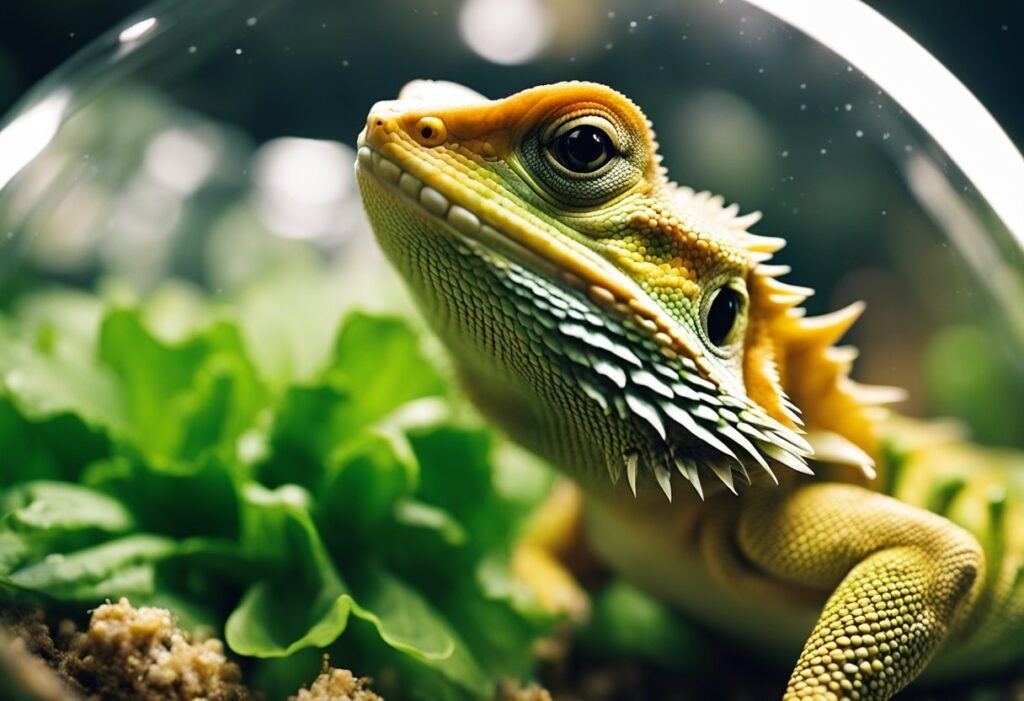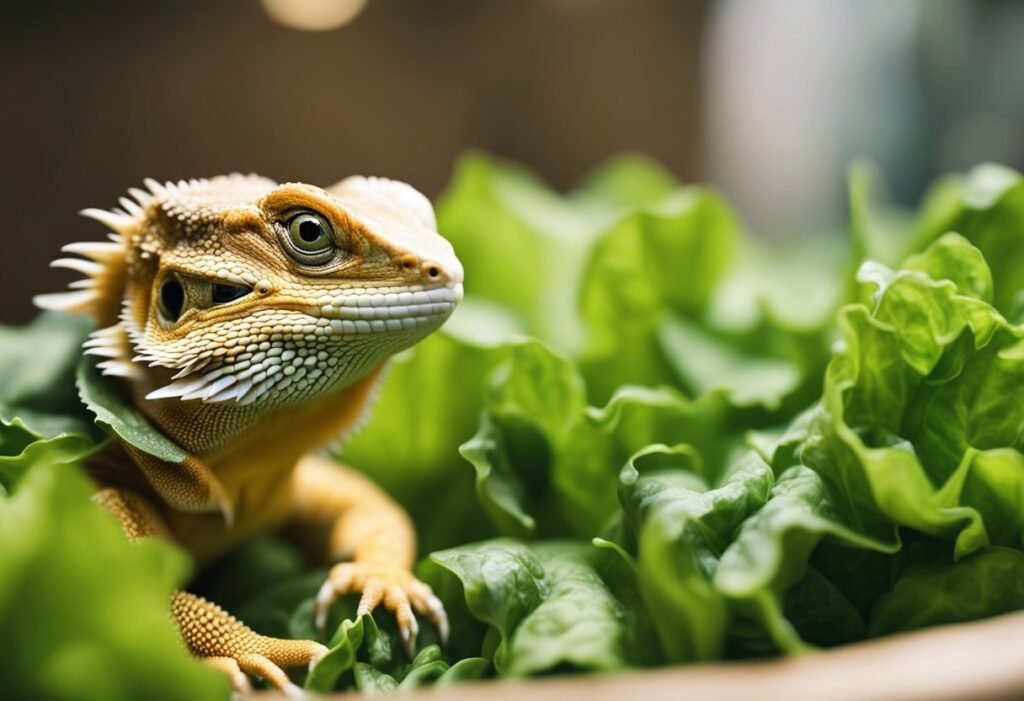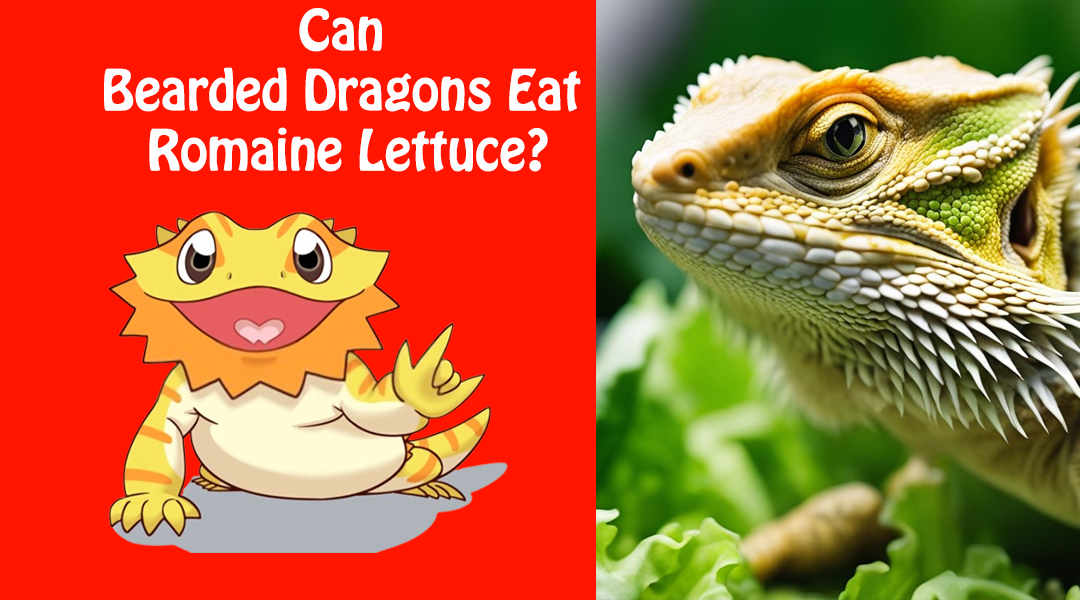Bearded dragons are fascinating pets that require a balanced diet to stay healthy. As owners, we want to provide our pets with the best nutrition possible. A common question that arises is whether bearded dragons can eat romaine lettuce. In this article, we will explore the topic and provide a clear answer.
Romaine lettuce is a popular leafy green vegetable that is often consumed by humans. However, when it comes to feeding it to bearded dragons, there are some important considerations to keep in mind. We will discuss the nutritional value of romaine lettuce and whether it is safe for bearded dragons to consume. Additionally, we will provide alternative greens that can be fed to your pet to ensure a balanced diet. By the end of this article, you will have a clear understanding of whether romaine lettuce should be a part of your bearded dragon’s diet.
Bearded Dragon Diet Fundamentals

Nutritional Needs
As responsible pet owners, it is important to understand the nutritional needs of our bearded dragons. Bearded dragons are omnivores, meaning they require a balanced diet of both plant and animal matter. They need a variety of nutrients, including protein, calcium, vitamins, and minerals, to maintain their health and well-being.
Protein is important for muscle growth and repair, while calcium is essential for strong bones and teeth. Vitamins and minerals help with various bodily functions, such as digestion and immune system health.
Safe Foods for Bearded Dragons
When it comes to feeding our bearded dragons, it is important to only give them safe and nutritious foods. Some foods can be harmful or toxic to them, so we must be careful in our selection.
Safe foods for bearded dragons include a variety of vegetables, fruits, and insects. Some examples of safe vegetables include collard greens, kale, and squash. Safe fruits include berries, mango, and papaya. Insects such as crickets, mealworms, and dubia roaches are also safe and provide a good source of protein.
It is important to note that while some vegetables, such as romaine lettuce, are safe for bearded dragons to eat, they should not be the main staple of their diet. Romaine lettuce has a high water content and lacks the necessary nutrients to provide a balanced diet. Instead, we should focus on providing a variety of safe and nutritious foods to ensure our bearded dragons are getting all the nutrients they need.
In conclusion, understanding the nutritional needs of our bearded dragons and providing them with a balanced and varied diet is crucial for their health and well-being. By feeding them safe and nutritious foods, we can ensure they live long and happy lives.
Romaine Lettuce and Bearded Dragons

When it comes to feeding bearded dragons, it is important to provide them with a balanced and nutritious diet. One of the common questions that pet owners ask is whether bearded dragons can eat romaine lettuce. In this section, we will explore the nutritional profile of romaine lettuce, the benefits and risks of feeding it to bearded dragons.
Nutritional Profile of Romaine Lettuce
Romaine lettuce is a leafy green vegetable that is rich in vitamins and minerals. It is low in calories and high in fiber, making it a great addition to any healthy diet. Here is a breakdown of the nutritional content of romaine lettuce:
| Nutrient | Amount per 100g |
|---|---|
| Calories | 17 |
| Protein | 1.2g |
| Fat | 0.3g |
| Carbohydrates | 3.3g |
| Fiber | 2.1g |
| Vitamin A | 871µg |
| Vitamin K | 48.2µg |
| Folate | 64µg |
| Calcium | 33mg |
| Iron | 0.5mg |
| Magnesium | 11mg |
| Potassium | 247mg |
Benefits of Romaine Lettuce for Bearded Dragons
Romaine lettuce can be a healthy addition to a bearded dragon’s diet. It is low in oxalates, which can be harmful to reptiles, and high in fiber, which can aid in digestion. Additionally, romaine lettuce is a good source of vitamin A, which is important for maintaining healthy eyesight and skin.
Risks of Feeding Romaine Lettuce
While romaine lettuce can be a healthy addition to a bearded dragon’s diet, it should be fed in moderation. Too much romaine lettuce can lead to diarrhea and other digestive issues. Additionally, romaine lettuce is low in calcium and high in phosphorus, which can lead to metabolic bone disease if fed in excess.
In conclusion, romaine lettuce can be a healthy addition to a bearded dragon’s diet when fed in moderation. It is important to provide a balanced and varied diet to ensure that your bearded dragon gets all the nutrients it needs to thrive.
Feeding Romaine Lettuce to Bearded Dragons

When it comes to feeding bearded dragons, it’s important to ensure they have a balanced diet that includes a variety of greens and vegetables. Romaine lettuce is one of the greens that can be added to their diet, but it’s important to know how to prepare and serve it properly.
How to Prepare Romaine Lettuce
Before serving romaine lettuce to your bearded dragon, it’s important to wash it thoroughly to remove any dirt or pesticides. Cut the lettuce into small pieces, removing any tough stems or veins that may be difficult for your pet to digest.
Appropriate Serving Size
While romaine lettuce can be a healthy addition to your bearded dragon’s diet, it should not be the sole source of their greens. A good rule of thumb is to provide a variety of greens and vegetables, with romaine lettuce making up no more than 20% of their total diet.
The appropriate serving size of romaine lettuce will vary depending on the age and size of your bearded dragon. As a general guideline, a serving size should be roughly the size of your pet’s head.
Frequency of Feeding Romaine Lettuce
Romaine lettuce can be fed to your bearded dragon once or twice a week. It’s important to remember that while it can be a healthy addition to their diet, it should not be the sole source of their greens.
In conclusion, romaine lettuce can be a healthy addition to your bearded dragon’s diet when served appropriately. By following the guidelines outlined above, you can ensure that your pet receives a balanced and nutritious diet.
Alternative Greens for Bearded Dragons
When it comes to feeding our bearded dragons, it’s important to provide them with a variety of greens to ensure they get the nutrients they need. While romaine lettuce is a popular choice, there are plenty of other greens that can be incorporated into their diet.
Recommended Greens
Here are some greens that we recommend feeding your bearded dragon:
- Collard Greens: High in calcium, collard greens are a great addition to your dragon’s diet. They also contain vitamin A and K.
- Mustard Greens: Rich in vitamin A and calcium, mustard greens are a great source of nutrition for your dragon.
- Dandelion Greens: These greens are packed with vitamins and minerals, including calcium, iron, and vitamin A. They’re also low in oxalates, which can be harmful to your dragon in large amounts.
- Turnip Greens: Another great source of calcium and vitamin A, turnip greens are a tasty addition to your dragon’s diet.
Greens to Avoid
While there are many greens that are safe for your bearded dragon to eat, there are some that should be avoided. These include:
- Spinach: High in oxalates, spinach can bind to calcium and prevent your dragon from absorbing it.
- Kale: While kale is a good source of nutrition, it’s also high in calcium oxalates, which can be harmful to your dragon in large amounts.
- Beet Greens: While beet greens are safe in small amounts, they’re high in oxalates and should be fed sparingly.
Overall, it’s important to provide your bearded dragon with a variety of greens to ensure they get the nutrients they need. By incorporating a mix of recommended greens into their diet, you can help keep your dragon healthy and happy.
Monitoring Your Bearded Dragon’s Health

As responsible pet owners, it is important to monitor our bearded dragon’s health regularly. This includes observing their behavior, physical appearance, and diet. In this section, we will discuss some signs of nutritional imbalance and when to consult a veterinarian.
Signs of Nutritional Imbalance
Bearded dragons require a balanced diet to stay healthy. A diet lacking in essential nutrients can lead to health problems. Signs of nutritional imbalance include:
- Lethargy and weakness
- Loss of appetite
- Weight loss
- Diarrhea or constipation
- Metabolic bone disease
If you notice any of these signs, it is important to evaluate your bearded dragon’s diet and make necessary adjustments. It is also recommended to consult with a veterinarian to ensure your pet receives proper treatment.
When to Consult a Veterinarian
Regular visits to a veterinarian are recommended to ensure your bearded dragon’s health. However, there are certain situations when immediate veterinary care is necessary. These include:
- Severe weight loss or lack of appetite
- Difficulty breathing or gasping for air
- Abnormal swelling or lumps
- Bleeding from the mouth or nose
- Seizures or tremors
If you notice any of these symptoms, seek veterinary care immediately. It is better to be safe than sorry when it comes to the health of your bearded dragon.
Frequently Asked Questions
What types of lettuce are safe for bearded dragons to consume?
Not all types of lettuce are safe for bearded dragons to consume. Romaine lettuce is considered safe for them to eat in moderation, but other types of lettuce such as iceberg lettuce should be avoided as they do not provide any nutritional value and can cause digestive issues.
How frequently should bearded dragons be fed romaine lettuce?
Romaine lettuce should only be fed to bearded dragons occasionally, as a treat or supplement to their main diet. It should not be a regular part of their diet as it does not provide all the necessary nutrients they need to thrive.
Which vegetables are considered healthy for a bearded dragon’s diet?
Bearded dragons require a varied diet that includes a mix of vegetables, fruits, and insects. Some vegetables that are considered healthy for their diet include collard greens, mustard greens, dandelion greens, and butternut squash.
Can a bearded dragon have carrots, and if so, how often?
Carrots can be given to bearded dragons in moderation as they are high in sugar content. It is important to chop them up into small pieces to prevent choking and to feed them only occasionally.
What fruits are recommended for bearded dragons to eat?
Fruits should also be given to bearded dragons in moderation as they are high in sugar content. Some recommended fruits include blueberries, raspberries, mango, and papaya.
Why might a bearded dragon refuse to eat lettuce, and what can be done about it?
There could be various reasons why a bearded dragon may refuse to eat lettuce, such as being fed too much of it or not being interested in the taste. If this happens, it is important to offer a variety of other vegetables and fruits to ensure they are still getting a balanced diet.

I, Mark Antonelli am highly interested in pet care tips. The experiences I gained through university life in animal sciences were also helpful to identify the best tricks for caring for and feeding varying kinds of pets. I know the majority of people love to own a pet. Yet, there is a guilty of owing a Bearded Dragon due to a lack of information about how much friendly and peaceful they are. I thought of filling this gap with detailed writings about this Pogona genus Bearded Dragon. All my team is also giving me great support to fulfil my mission. Hope you will enjoy the journey with us.

